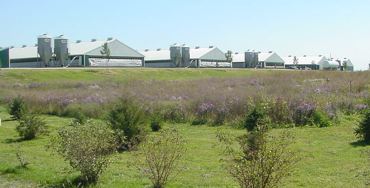Siting Animal Facilities to Reduce Neighbor Nuisance

Assessing Downwind Direction
Wind direction and speed affect dust and odor risks for neighbors of animal feeding operations. A first step in assessing and minimizing potential dust and odor nuisance risk of a livestock operation is identifying the most likely downwind directions. This article will share wind frequency data for 44 Nebraska locations to consider siting options for reducing these nuisances.
Different wind speeds cause different challenges. High wind speed increases risk for dust, while low wind speeds and cooling conditions (typically, nighttime conditions) increase the risk of odor impacting neighbors. Information on the prevalence of wind direction is available for many locations and may be illustrated as a ‘wind rose’. The visuals presented here show downwind direction – where dust and odorous air are most likely to go – using the same rose concepts; the longer the petal, the more often air will head in that direction (Figure 1), with the frequency given as a percentage of total hours.
Figure 1. Example downwind direction frequency for assessing dust risk (left) and odor risk (right, low wind speed).
Siting Animal Facilities
Downwind direction frequency can be used to evaluate sites for a new or expanding livestock facility, as dust and odor risk depend largely upon 1) downwind direction frequency and 2) separation distance. Note that higher-risk directions for dust (all wind speeds) may differ from those for odor (low speeds). Using these plots along with satellite images or plat maps can assist in initial screening of facility locations.
For many Nebraska locations, prevailing winds place neighbors to the north to northwest of a livestock production operation at a greater risk for experiencing nuisance odors and dust due to prevailing summer winds. Prevailing winter winds may also impact neighbors to the south or southeast of a new facility. Often, moving a proposed facility to the east or west can substantially change the impact on your neighbors.
Note that these graphics illustrate only the direction of potential risk, not separation distance. Tools such as the Nebraska Odor Footprint Tool provide information on separation. Nebraska Extension has additional information on minimizing odor and dust risks.
How to Use This Tool
Each marker on the map below marks the location of a weather monitoring system. When you click on a marker, a downwind frequency chart for that location will be displayed. Using these charts, you can analyze the direction frequency and speed of wind in that location. With this information, animal producers can better select sites for their animal housing and manure storage facilities to minimize potential nuisance risks for neighbors. If you have options for siting a new facility, try alternatives to the east and west of your proposed site to see if you can reduce potential odor and dust risks for neighbors by moving away from locations that place neighbors in the path of the higher frequency rose petals.
This article was reviewed by Richard Stowell, Stonie Cooper, Martha Shulski, Crystal Powers
Sign up for updates from UNL Water
